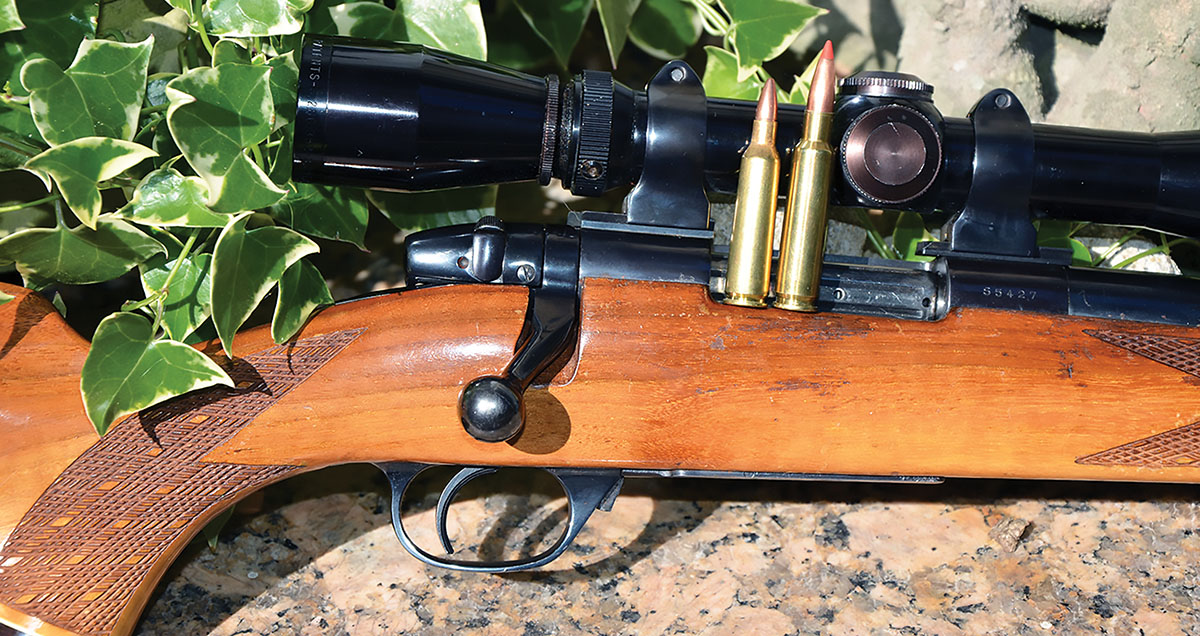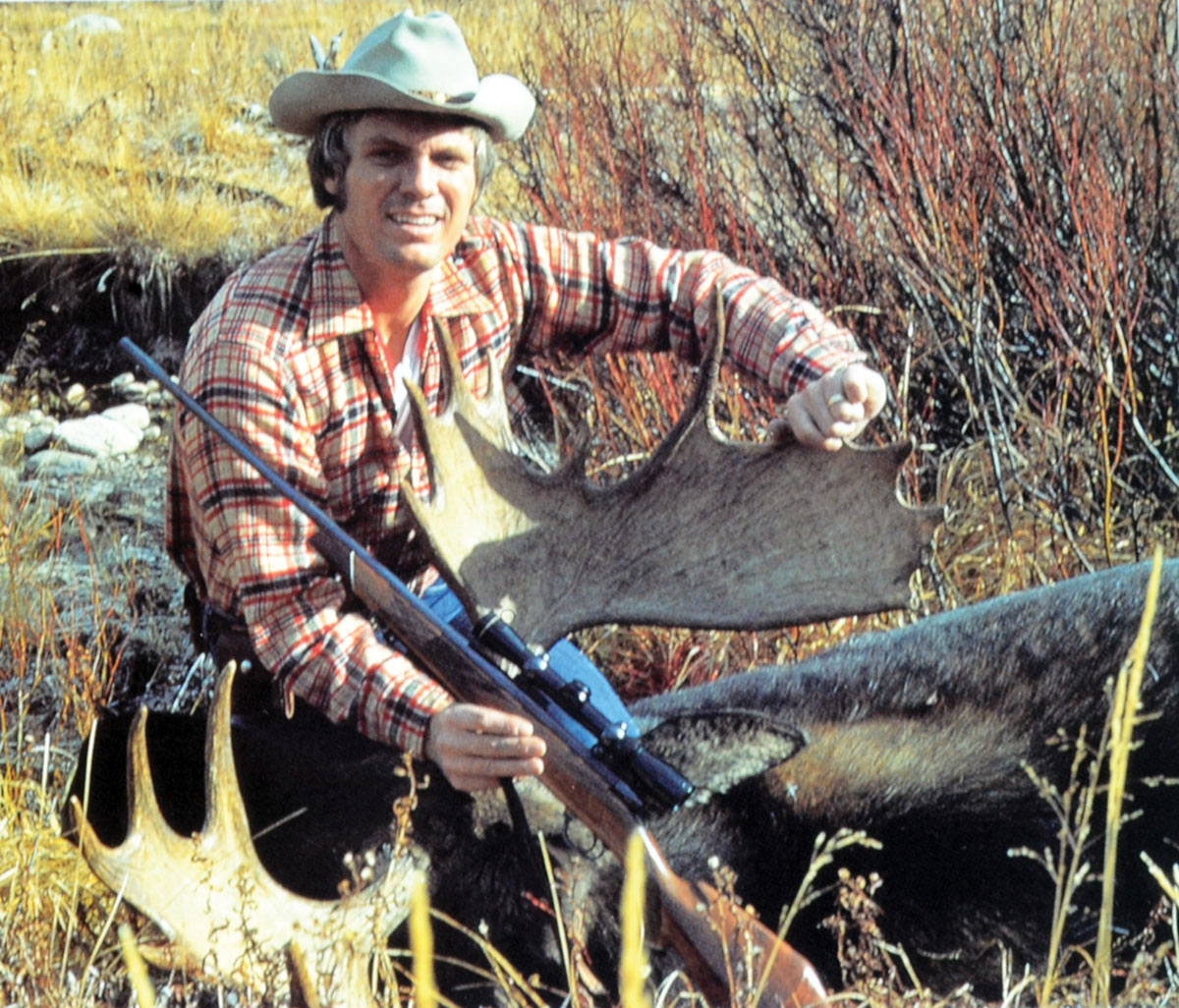Soon after Phyllis and I were married, we became friends with Wyoming cattle ranchers Dick and Dorothy Keenan and hunted with them for several years. In addition to taking very good mule deer and pronghorn antelope on their property, on some years, the four of us would travel to the Bridger National Forest which was renowned for excellent elk hunting. Very nice bulls were harvested by all. It was during one of those hunts that bighorn sheep became the topic of conversation, and that got me hooked. Soon after returning home, I decided to start applying for a tag for an area described by a friendly game warden as one of the steepest and most rugged places in all of Wyoming. As he went on to say, my chances of drawing a tag were better there than in other areas because, due to its difficulty, fewer hunters applied. In that same year, I also began applying for a non-resident tag for Shiras moose as well.

Originally in 22-250 Remington (left), the action of this Weatherby VarmintMaster was modified for the 7mm-308 Improved (right).
Among factory rifles in those days, the Winchester Model 70 Featherweight at 8.5 pounds with scope may have been the lightest. After deciding that lighter would be better for a backpack hunt in the high country, I found the weight I was looking for in a Weatherby VarmintMaster resting in the used gun rack at a local gun shop. For those who are not familiar with that beautiful little rifle of yesteryear, its action is a drastically scaled-down version of the standard Mark V action, and it was available only in 22-250 and 224 Weatherby Magnum. When Roy Weatherby introduced his standard-size Mark V action in 1957, he had already designed the 224 Magnum with its belted case, but he did not have the funds required to develop a smaller action for it. For this reason, he did not get around to introducing the VarmintMaster and its ammunition until 1963. A ground-hog-shooting friend bought one and loved it, but with a 55-grain bullet at 3,750 feet per second (fps), its performance was too close to that of the 22-250, and it never became as popular as Weatherby rifles on the standard-size action. Adding the 22-250 option helped sales but not enough to prevent the VarmintMaster from being discontinued in 1994.
When buying the used VarmintMaster in 22-250, my first thought was a conversion to 270 Savage – an old wildcat formed by necking down the 300 Savage case and originally intended for the Savage 99 rifle. The Ackley Improved version used a bit more powder but it was slower than desired with a 130-grain bullet. The 308 Winchester case necked down for 7mm bullets would be a bit better, with an improved version adding more icing to the cake. Making it work in the tiny Weatherby action was not exactly falling-off-a-log easy.

These three bullets accounted for all the game taken by Layne and his wife Phyllis during the first year the rifle in 7mm-308 Improved was used.
First of all, the magazine had to be lengthened. This was accomplished by purchasing another magazine from Weatherby, chopping the needed length from its rear end, and welding it to the rear of the original magazine after its rear plate had been removed. This required lengthening its slot in the stock as well as lengthening its opening in the bottom of the receiver by the same amount. Bolt travel also had to be increased. The bolt stop on the Weatherby is a steel pin that protrudes through the bottom of the receiver, with its lower end riding in a groove machined into the bottom of the bolt. Increasing the length of the groove at its front end .300 inch allowed the bolt to travel far enough to the rear to pick up the longer cartridges from the magazine. Removing the recoil pad and drilling a couple of one-inch holes in the stock removed a bit of weight, as did using a drill to Swiss cheese the magazine box. The total weight of the rifle with scope, three cartridges and a lightweight sling was just an ounce beyond seven pounds.
Gunsmith Wally Strutz in Eagle River, Wisconsin, did the action work and completed the project in early 1977. In the meantime, he had sent my cartridge dimensions to Clymer for a chamber reamer. Wally did an excellent job of fitting and contouring a Douglas premium-grade barrel for a perfect fit with the barrel channel of the Weatherby stock. In those days, RCBS was in the custom die business, and five cases fire-formed in the chamber of my new rifle and sent to Bill Keys of that company had a die set in my loading bench in a surprisingly short time. A Powley Computer indicated a velocity of 3,000 fps for a 140-grain bullet pushed along by 50.0 grains of IMR-4350. Homer’s cardboard computer proved to be dead on the money in velocity prediction but a bit high in the amount of that powder needed as 48.5 grains pushed a 140-grain Nosler Partition from the 24-inch barrel at an average of 2,999 fps with excellent accuracy. Winchester 785 and Norma MRP exceeded that, but not by enough to make a difference in the field. Neither of those is available today.

With scope, the modified Weatherby VarmintMaster with a 24-inch barrel in 7mm-308 Improved weighed only an ounce over seven pounds. This was quite light during an era when the Winchester Model 70 Featherweight at 8.5 pounds was quite light among factory-built rifles.
Old faithful IMR-4350 is still an excellent choice for this cartridge, but others with similar burn rates should work equally well. They include IMR 4451, Reloder 19, W-760, H-4350 and StaBALL 6.5. In other words, about any propellant that works in the 7mm-08 Remington. It has been quite a long time since I have used the rifle on anything larger than deer, and for that, the Nosler 140-grain Ballistic Tip has proven to be quite accurate and effective in the field as well. The 120-grain version of that bullet is considered by most to be best suited for use on varmints, but several years ago, a friend at Nosler informed me that it has the same jacket thickness as the 140-grain bullet and was actually designed for use on deer. Soon thereafter, I proved him correct by taking a Colorado mule deer at just over 300 yards. Exiting the muzzle at 3,100 fps and sighted three inches high at 100 yards, that bullet strikes a 300-yard target about two inches below the point of aim and is still moving along at just over 2,400 fps. On the other hand, while the 140-grain Ballistic Tip begins its journey slower, it shoots as flat and delivers a bit more downrange punch as well. Both are excellent choices.

After many years of applying for a non-resident permit for a Shiras moose in Wyoming, I finally received one with this bull being the first game taken with the VarmintMaster in 7mm-308 Improved. A handload with the Nosler 140-grain Partition was used.
After many unsuccessful years of applying for a sheep tag, I eventually got busy with other matters and threw in the towel. On a brighter note, soon after the rifle was completed, a non-resident moose tag appeared in my mailbox. Having hunted on my own in Wyoming or other game for several years, my first thought was to do just that for moose, but drawing a tag was a once-in-a-lifetime experience, so I counted my money and booked a hunt with outfitter Bud Callahan out of his Box Y ranch in the Greys River area. On the afternoon of the fifth day, I took a good bull at about 125 yards, and it was in an area I had hunted elk and mule deer several times in the past. In fact, I was more familiar with the lay of the land than the outfitter, and I may have previously glassed the moose I ended up shooting. One Nosler 140-grain Partition close behind the shoulder ended the hunt, and while field-dressing the bull, we found it nicely expanded against the offside hide.
During that same year, Phyllis and I used the rifle in 7mm-08 Improved loaded with the Speer 130-grain boat tail spitzer at just over 3,100 fps to take excellent pronghorn antelope. Months later, I headed to Rhodesia with a rifle in 375 H&H Magnum for buffalo and the little Weatherby for various antelope up to the size of sable and greater kudu. A mature kudu bull can weigh as much as 600 pounds and of all the antelope of Africa, it is my favorite to hunt. I used the fairly-new Speer 160-grain Grand Slam seated atop 50.0 grains of W-785 for a velocity of 2,710 fps, and everything taken with the rifle was a one-shot kill. Those bullets were the original design, with the lead core soft at the front for expansion and harder from about the middle to the rear for weight retention.





.jpg)


